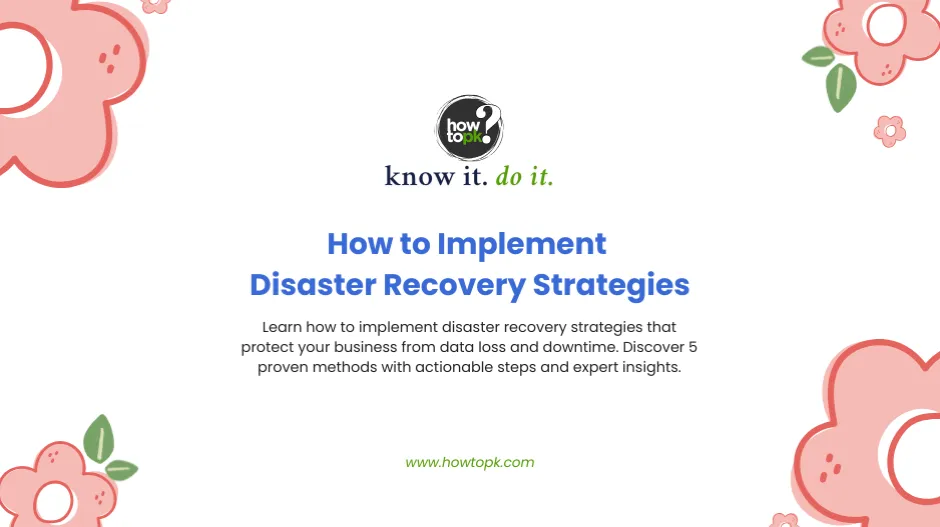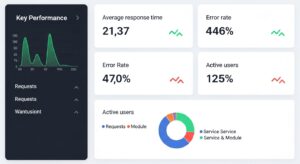When disaster strikes your business, will you be prepared? Statistics show that 60% of companies that lose their data shut down within six months. This sobering reality makes implementing disaster recovery strategies not just important—it’s absolutely critical for your organization’s survival.
Disaster recovery strategies encompass the policies, procedures, and technologies that enable your business to recover and continue operations after a disruptive event. Whether facing natural disasters, cyberattacks, or system failures, having a robust disaster recovery plan can mean the difference between quick recovery and permanent closure.
Understanding the Foundation of Disaster Recovery Strategies
Before diving into implementation, let’s explore what makes an effective disaster recovery strategy. At its core, disaster recovery involves creating systematic approaches to restore critical business functions and data after an interruption.
The most successful disaster recovery strategies address three key components: prevention, response, and recovery. Prevention focuses on minimizing risks before they occur. Response involves immediate actions during a crisis. Recovery encompasses the steps needed to restore normal operations.
Consider this: What would happen to your business if your primary server crashed right now? How long could you operate without access to customer data or financial records? These questions highlight why disaster recovery planning demands immediate attention.
Strategy 1: Comprehensive Risk Assessment and Business Impact Analysis
The foundation of any effective disaster recovery strategy begins with understanding your vulnerabilities. A comprehensive risk assessment identifies potential threats to your organization, while business impact analysis determines how these threats could affect your operations.
Start by cataloging all potential risks your business faces. Natural disasters like floods, earthquakes, or hurricanes represent obvious threats. However, don’t overlook human-caused incidents such as cyberattacks, employee errors, or equipment failures. According to the Federal Emergency Management Agency (FEMA), businesses should evaluate risks based on probability and potential impact.
Risk Assessment Framework:
Risk Category | Examples | Probability | Impact Level |
Natural Disasters | Floods, fires, storms | Low-Medium | High |
Cyber Threats | Ransomware, data breaches | High | High |
Hardware Failures | Server crashes, network outages | Medium | Medium-High |
Human Error | Accidental deletions, misconfigurations | High | Medium |
Your business impact analysis should identify Recovery Time Objectives (RTO) and Recovery Point Objectives (RPO) for each critical system. RTO represents the maximum acceptable downtime, while RPO indicates the maximum acceptable data loss. These metrics guide your disaster recovery strategies and investment decisions.
Strategy 2: Implementing Robust Data Backup and Recovery Solutions
Data backup forms the cornerstone of disaster recovery strategies. Without reliable backups, recovering from data loss becomes impossible. The most effective approach follows the 3-2-1 backup rule: maintain three copies of critical data, store them on two different media types, and keep one copy offsite.
Modern disaster recovery strategies leverage multiple backup technologies. Local backups provide quick recovery for minor incidents, while cloud-based solutions offer protection against site-wide disasters. Hybrid approaches combine both methods for comprehensive coverage.
Backup Strategy Options:
- Full Backups: Complete copies of all data, providing comprehensive protection but requiring significant time and storage space.
- Incremental Backups: Copy only data changed since the last backup, offering faster backup times but potentially slower recovery.
- Differential Backups: Backup all changes since the last full backup, balancing speed and recovery efficiency.
Consider implementing continuous data protection (CDP) for mission-critical systems. CDP creates real-time backups, minimizing data loss potential. Leading providers like Veeam and Acronis offer enterprise-grade solutions supporting various disaster recovery strategies.
Regular backup testing proves essential. Many organizations discover backup failures only when attempting recovery during actual emergencies. Schedule monthly recovery tests to verify backup integrity and refine your disaster recovery procedures.
Strategy 3: Creating Redundant Systems and Infrastructure
Infrastructure redundancy eliminates single points of failure within your disaster recovery strategies. By duplicating critical systems and components, you ensure continued operations even when primary systems fail.
Network redundancy involves multiple internet connections from different providers. If one connection fails, traffic automatically routes through backup connections. Geographic redundancy places critical systems in multiple locations, protecting against regional disasters.
Server virtualization enhances disaster recovery capabilities by abstracting applications from physical hardware. Virtual machines can quickly migrate to different physical servers or cloud platforms during emergencies. This flexibility makes virtualization a cornerstone of modern disaster recovery strategies.
Infrastructure Redundancy Checklist:
Power systems require uninterruptible power supplies (UPS) and backup generators. Network infrastructure needs redundant switches, routers, and internet connections. Storage systems should implement RAID configurations and replicated databases.
Cloud computing platforms offer built-in redundancy features. Amazon Web Services (AWS), Microsoft Azure, and Google Cloud provide disaster recovery services that automatically replicate data across multiple data centers. These platforms integrate seamlessly with existing disaster recovery strategies.
Strategy 4: Developing Comprehensive Emergency Response Procedures
Even the best disaster recovery strategies fail without clear emergency response procedures. Your emergency response plan should outline specific actions for different disaster scenarios, assign responsibilities to team members, and establish communication protocols.
Create detailed response procedures for various disaster types. Cyber security incidents require different responses than natural disasters or hardware failures. Each procedure should include immediate response actions, escalation protocols, and recovery initiation steps.
Emergency Response Team Structure:
Designate specific roles within your emergency response team. The incident commander coordinates overall response efforts. Technical teams handle system recovery tasks. Communications teams manage internal and external communications. Business continuity teams focus on maintaining critical operations.
Communication plans prove crucial during disasters. Establish primary and backup communication methods for reaching team members, customers, and vendors. Consider that normal communication channels might be unavailable during disasters.
Document all procedures in accessible formats. Digital copies might be inaccessible during certain disasters, so maintain printed copies in secure locations. Regular training ensures team members understand their roles within your disaster recovery strategies.
Strategy 5: Regular Testing and Continuous Improvement
Disaster recovery strategies require ongoing maintenance and improvement. Regular testing identifies weaknesses before real disasters occur, while continuous improvement ensures your plans remain effective as your business evolves.
Implement different types of disaster recovery tests throughout the year. Tabletop exercises involve discussing response procedures without actually executing them. These low-cost tests help identify procedural gaps and training needs.
Partial tests involve actually executing portions of your disaster recovery plan. For example, you might test database recovery procedures or failover to backup systems. Full-scale tests simulate complete disaster scenarios, providing comprehensive evaluation of your disaster recovery strategies.
Testing Schedule Framework:
Test Type | Frequency | Duration | Scope |
Tabletop Exercises | Quarterly | 2-4 hours | All procedures |
Partial Tests | Monthly | 4-8 hours | Specific systems |
Full-Scale Tests | Annually | 1-2 days | Complete plan |
Document all test results and create improvement plans based on findings. Track metrics such as recovery times, data loss amounts, and procedure effectiveness. These measurements guide future investments in your disaster recovery strategies.
Post-incident reviews following actual disasters provide valuable learning opportunities. Analyze what worked well and identify areas for improvement. Update your disaster recovery strategies based on these real-world experiences.
Advanced Considerations for Enterprise Disaster Recovery
Large enterprises require sophisticated disaster recovery strategies addressing complex, interconnected systems. Multi-site deployments, regulatory compliance requirements, and extensive vendor relationships create additional challenges requiring specialized approaches.
Geographic distribution of operations necessitates coordinated disaster recovery strategies across multiple locations. Each site needs local procedures while maintaining integration with overall corporate plans. Consider dependencies between locations and plan for scenarios affecting multiple sites simultaneously.
Regulatory compliance adds complexity to disaster recovery strategies. Industries such as healthcare, finance, and government face specific requirements for data protection and business continuity. Ensure your plans meet all applicable regulations while maintaining operational effectiveness.
Technology Trends Shaping Future Disaster Recovery Strategies
Emerging technologies continue transforming disaster recovery strategies. Artificial intelligence and machine learning enable predictive failure detection and automated response procedures. These technologies can identify potential issues before they cause system failures.
Edge computing brings processing power closer to data sources, reducing dependency on centralized systems. This distributed approach enhances resilience within disaster recovery strategies by eliminating single points of failure.
Containerization and microservices architectures improve disaster recovery capabilities by enabling granular system recovery. Rather than recovering entire applications, organizations can restore specific components while maintaining partial functionality.
Measuring Success and ROI of Disaster Recovery Strategies
Effective disaster recovery strategies require measurable outcomes and clear return on investment (ROI) calculations. Key performance indicators (KPIs) help assess the effectiveness of your disaster recovery investments and guide future improvements.
Primary metrics include RTO and RPO achievement rates. Track how often you meet your recovery objectives during tests and actual incidents. Cost metrics should consider both direct disaster recovery expenses and potential business losses prevented.
Business continuity metrics measure your ability to maintain operations during disruptions. Customer satisfaction scores during incidents provide insight into the effectiveness of your disaster recovery strategies from an external perspective.
Implementation Roadmap for Disaster Recovery Strategies
Successfully implementing disaster recovery strategies requires a structured approach spanning several months. Begin with executive sponsorship and budget allocation, then proceed through assessment, planning, implementation, and testing phases.
Month 1-2 focus on risk assessment and business impact analysis. Engage stakeholders across all business units to identify critical systems and recovery requirements. Month 3-4 involve developing detailed recovery procedures and selecting appropriate technologies.
Month 5-8 concentrate on implementing chosen solutions and conducting initial testing. Month 9-12 emphasize comprehensive testing, staff training, and plan refinement. Remember that disaster recovery strategies require ongoing attention beyond initial implementation.
Conclusion
Implementing effective disaster recovery strategies protects your business from potentially catastrophic losses while ensuring operational resilience. The five strategies outlined—comprehensive risk assessment, robust data backup, redundant infrastructure, emergency response procedures, and regular testing—provide a foundation for business continuity.
Success requires commitment from leadership, adequate resource allocation, and ongoing attention to plan maintenance. Start with the most critical systems and gradually expand coverage to encompass your entire operation.
The investment in disaster recovery strategies pays dividends through reduced downtime, protected revenue streams, and enhanced customer confidence. In today’s interconnected business environment, disaster recovery planning isn’t optional—it’s essential for long-term success.











